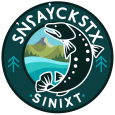Photo Credit: Mike Graeme
Canoes
We are water people. The rivers and lakes of our territory were highways for our ancestors. The canoe was always our main method of transportation, for families and food. In traditional times, we used two different types of canoe. Today, we are restoring our cultural relationship with both.
Dugout
In 2016, on the verge of going to court in Nelson to protect Rick Desautel’s right to hunt, we lost two important leaders: Virgil Seymour and Jim Boyd. Our community was deeply saddened.
That same year, we renewed an ancient practice: the canoe journey to Kettle Falls and the great salmon fishery.
Tribes from around the region joined us in carving dugout canoes from whole cedar logs and putting them on the water for a canoe journey to the once prolific Kettle Falls fishery. For the first time in a long time, we journeyed by water, from the Arrow Lakes to the southern end of our territory.
In years since, we have expanded the distance we travel in our territory, paddling in high winds, driving rain and strong currents.
UNITED BY WATER
Watch the trailer for United by Water, a film by Sinixt filmmaker Derrick J. LaMere about Kettle Falls and the return of traditional dugout canoes.
Sturgeon-Nosed
This canoe excels in both lake and fast-river-current conditions. It is light-weight, for portaging around high water falls. Our ancestors scuttled these canoes underwater through winter, to preserve them. They crafted them from whole sheets of white pine bark, a tree native to our mountain territory.
Shawn Brigman, a Spokane and Sinixt tribal descendant, has worked for years to restore our relationship with this elegant canoe design. In 2013, he established Salish Sturgeon Nose Canoes, his unique interpretation of the ancient craft.




